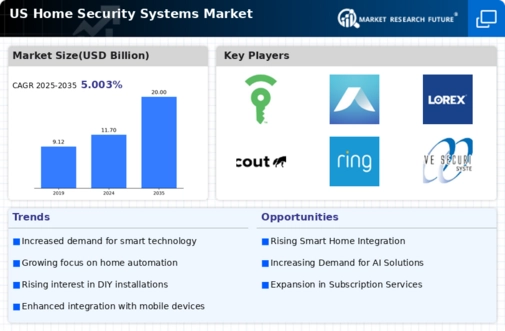Rising Crime Rates
The home security-systems market is experiencing heightened demand due to rising crime rates across various regions in the US. According to the FBI's Uniform Crime Reporting Program, property crimes have shown an upward trend, prompting homeowners to seek enhanced security solutions. This increase in criminal activity has led to a greater awareness of the need for effective home protection. As a result, consumers are investing in advanced security systems that offer features such as real-time monitoring and remote access. The market is projected to grow as homeowners prioritize safety, with an estimated growth rate of 8% annually over the next five years. This driver indicates a strong correlation between crime statistics and the adoption of security technologies, suggesting that the home security-systems market will continue to thrive in response to these societal concerns.
Technological Advancements
Technological advancements play a pivotal role in shaping the home security-systems market. Innovations such as artificial intelligence, machine learning, and IoT (Internet of Things) are revolutionizing how security systems operate. These technologies enable features like facial recognition, smart alerts, and automated responses, enhancing the overall effectiveness of security measures. The integration of smart home devices with security systems is becoming increasingly common, allowing for seamless control and monitoring. As of 2025, the market is expected to reach a valuation of approximately $50 billion, driven by these technological innovations. The continuous evolution of technology not only improves security but also attracts a tech-savvy consumer base, indicating a robust future for the home security-systems market.
Regulatory Support and Incentives
Regulatory support and incentives are emerging as significant drivers for the home security-systems market. Various state and local governments in the US are implementing policies that encourage the adoption of security systems, including tax credits and rebates for homeowners who invest in security technologies. These initiatives aim to enhance public safety and reduce crime rates, creating a favorable environment for market growth. Additionally, insurance companies are increasingly offering discounts on premiums for homes equipped with security systems, further incentivizing consumers to invest in these solutions. This regulatory landscape is likely to bolster the home security-systems market, with projections indicating a potential increase in market size by 5% as more homeowners take advantage of these benefits.
Increased Awareness of Home Safety
There is a growing awareness of home safety among consumers, significantly impacting the home security-systems market. Educational campaigns and media coverage regarding home invasions and burglaries have heightened public consciousness about the importance of security. This awareness is leading to a shift in consumer behavior, with more individuals actively seeking out security solutions. Surveys indicate that nearly 70% of homeowners consider security systems a necessity rather than a luxury. This trend is likely to drive market growth, as consumers prioritize investments in security systems to protect their families and property. The home security-systems market is expected to benefit from this increased awareness, potentially leading to a market expansion of 10% over the next few years.
Growing Demand for Remote Monitoring
The demand for remote monitoring solutions is significantly influencing the home security-systems market. As lifestyles become increasingly mobile, homeowners are seeking systems that allow them to monitor their properties from anywhere. The proliferation of smartphones and mobile applications has made it easier for consumers to access real-time surveillance footage and receive alerts on their devices. This trend is reflected in market data, which shows that remote monitoring features are among the most sought-after attributes in security systems. By 2026, it is anticipated that over 60% of new security system installations will include remote monitoring capabilities. This growing demand indicates a shift towards more flexible and user-friendly security solutions, positioning the home security-systems market for continued growth.



















Leave a Comment